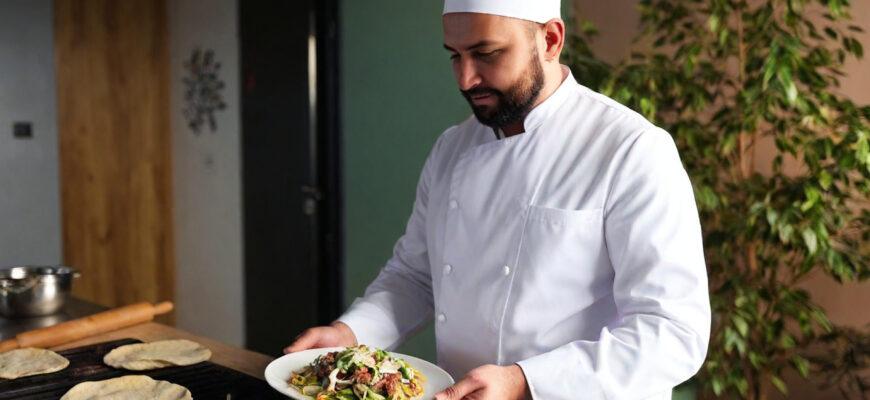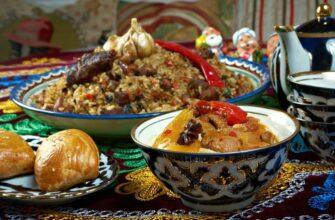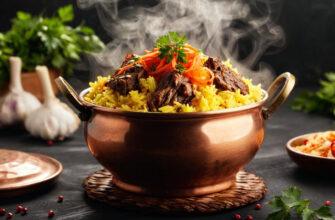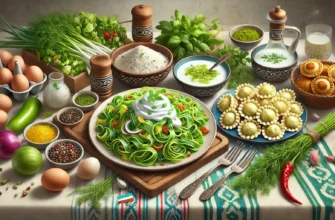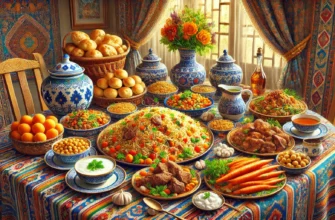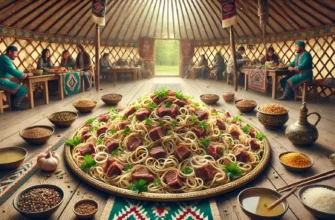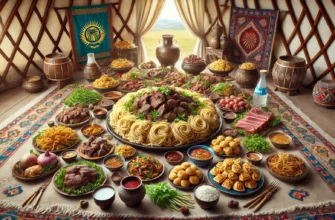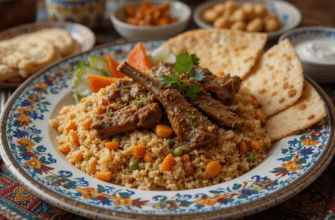Kazakh Cuisine: A Comprehensive Guide to Traditional and Modern Food
Kazakhstan’s culinary heritage reflects its nomadic history, diverse cultural influences, and rich agricultural background. This comprehensive guide explores traditional Kazakh dishes, modern food trends, and everything you need to know about the country’s unique gastronomy.
The History and Foundations of Kazakh Cuisine
Kazakh food is profoundly rooted in the nomadic past of the Kazakh people. The cuisine developed within the constraints of a nomadic lifestyle, where people relied heavily on their animals for sustenance. This historical context shaped several key characteristics of traditional Kazakh cooking:
Nomadic Influence on Food Preparation
The nomadic lifestyle necessitated food preservation methods, resulting in many dishes based on smoked meat and fermented milk products. Food preparation techniques primarily involved boiling, stewing, and steaming rather than frying. This approach developed essentially to ensure food could be preserved during long journeys across the vast Kazakh steppe.
Core Ingredients
Three fundamental elements form the backbone of traditional Kazakh cuisine:
- Meat: Predominantly mutton, horsemeat, and beef
- Dough: Used in various forms from noodles to pastries
- Onions: A staple flavoring in most dishes
As one Kazakh food expert succinctly noted, “Kazakh cuisine boils down to meat, dough and onions. Just various combinations of those three”.
Popular Kazakh Dishes
Beshbarmak – Kazakhstan’s National Dish
Beshbarmak, which literally means “five fingers,” is considered the most iconic dish in Kazakh cuisine. The name references the traditional way of eating this dish by hand.
The dish consists of:
- Finely chopped boiled meat (typically mutton, horse, or beef)
- Flat egg noodles
- Onion sauce called “chyk”
- Meat broth (shorpo) served as a first course
The serving of beshbarmak follows a specific ritual where different cuts of meat (ustukan) are served to different people based on their gender, age, and social rank. During festive occasions, beshbarmak may include kazy and chuchuk (horse meat delicacies).
Other Traditional Meat Dishes
Kazy (Horse Meat Sausage)
Kazy is a traditional horse meat sausage that holds special cultural significance. It’s made from the meat that lies on the frontal ribs, combined with fat, seasoned with black pepper and salt, placed in sheep intestine, air-cured without smoke, and finally cooked in slow boiling water.
Chuchuk
Another horse meat delicacy that is served as a traditional treat, rather than being part of everyday meals. It’s considered a delicacy in Kazakh cuisine.
Noodle-Based Dishes
Lagman
A popular dish with Uyghur origins that has become an integral part of Kazakh cuisine. Kazakh lagman consists of:
- Long noodles
- Meat (usually beef without fat)
- Vegetables (bell peppers, onions, Chinese cabbage)
- Spices and herbs
Lagman may be served either as a soup with broth or as a noodle dish with thick vegetable gravy
. In cities like Almaty, restaurants such as Public and Lagmanhana are known for serving excellent and affordable lagman.
Dumplings and Pastries
Manti
Manti are steamed dumplings typically filled with meat, though vegetarian versions also exist. A vegan recipe might include:
- Onions, pumpkin, cabbage, and carrots for filling
- Jeera (cumin) seeds, salt, black pepper, dill, and chives for flavor
- Dough made from flour, water, and salt
Samsa
These are puff pastries filled with meat, potatoes, or cheese. Samsa is very popular as street food throughout Kazakhstan.
Bread Products
Baursak
Small chunks of square or round yeast dough fried in oil. They are central to Kazakh cuisine, as evidenced by the proverb: “Besbarmak-kuyrdak-baursak, and you can do without the rest!”
Shelpek
A thin unleavened bread fried in oil, often served with main courses.
Tandoor Nan
Everyday yeast bread baked in a clay oven (tandoor) that accompanies most meals.
Kazakh Food Culture
Dastarkhan: The Art of Kazakh Hospitality
In Kazakhstan, hospitality is expressed through the dastarkhan – a covered table with many dishes. There’s a saying: “before doing any business with the guest, feed him first”. The richness of a host’s dastarkhan is believed to reflect their hospitality and favorable fate.
Festive Dishes
Nauryz Kozhe
A special dish prepared for Nauryz (Persian celebration of a new season). Traditional Nauryz kozhe combines seven symbolic ingredients: meat, water, salt, grain, butter, flour, and milk. Modern versions may include additional ingredients according to personal taste preferences.
Sumalak
This dish consists of sprouted wheat that must be continuously stirred as it boils for a full day. The result is a thick, semisweet paste eaten during Nauryz celebrations.
What Do Kazakhs Eat for Breakfast?
The “typical Kazakh breakfast/tea” pattern identified in dietary studies includes:
- Fresh bread
- Margarine
- Milk
- Cheese
- Butter
In more modern settings, especially in cities, breakfast options have diversified with international influences. Kefir is often enjoyed either as a standalone drink or mixed with hot breakfast cereals.
Beverages in Kazakh Cuisine
Traditional Fermented Milk Drinks
Fermented milk products are very popular in Kazakhstan:
- Kumys: Fermented mare’s milk with a slightly alcoholic content
- Shubat: Fermented camel’s milk
- Katyk and Ayran: Made from cow’s milk
- Kefir: Consumed both as a drink and with breakfast cereals
Tea Culture
Tea holds a special place in Kazakh culture. Black tea is extremely popular, both at home and in social settings. Green tea is less common except for “Tashkent tea,” a mixture of black and green tea with lemon and honey.
A unique tea variant called Shyrchay combines black tea with milk, salt, butter, flour, and fried tail fat, though it’s typically only served in homes.
Is Kazakh Food Healthy?
Traditional Diet and Nutritional Value
The traditional Kazakh diet developed to provide high energy for the demanding nomadic lifestyle in harsh climate conditions. Consequently, foods tend to be calorically dense and contain substantial amounts of fat.
Research studies have found:
- Out-of-home eating may negatively impact nutritional quality when based on ultra-processed food
- It’s possible to maintain a healthy diet even when eating out by adhering to traditional Kazakh cuisine elements
- The traditional diet typically includes high protein content from meat, which provides essential nutrients like iron
Modern Dietary Concerns
As in many countries, Kazakhstan is experiencing a nutrition transition. Studies examining dietary factors in Kazakhstan have noted concerns about:
- Increased consumption of ultra-processed foods
- High sodium intake
- The need for balanced consumption of fats and carbohydrates
A trend toward healthier eating has emerged, particularly in urban areas, with greater awareness of nutritional considerations.
Vegetarianism in Kazakh Cuisine
Adapting Traditional Dishes
While traditional Kazakh cuisine is heavily meat-based, vegetarian adaptations are increasingly available:
- Vegetarian Manti: Filled with pumpkin, cabbage, carrots, and onions instead of meat
- Vegetarian Plov: Using chickpeas as a substitute for meat, creating a nutritious plant-based alternative
- Vegetable Lagman: The noodles and vegetable components without meat
One Reddit user suggested: “I would suggest making plov using chickpeas as a substitute for meat, which would be a great twist for Kazakhstan or Central Asian cuisine”.
Fruit-Based Dishes
Despite Kazakhstan being the birthplace of apples, they are interestingly not often featured in traditional dishes. As one food historian noted, “It’s a strange paradox: the birthplace of apples, yet apples are rarely used in local cuisine”. Apples are generally eaten as fresh fruit rather than incorporated into cooking.
Some Russian-influenced desserts that are common in Kazakhstan include:
- Sharlotka (a cake with apple slices)
- Mochyonye yabloki (brined apples)
Street Food in Kazakhstan
Popular Types of Street Food
Kazakhstan offers diverse street food options, with both traditional and international influences:
- Samsa: Savory pastries filled with meat, potatoes, or cheese
- Shaurma/Doner: Several places like Doner.KZ and Shoq Doner are known for quality doners in cities like Almaty
- Baursak: Fried bread pieces that are popular for quick snacks
Budget-Friendly Places in Almaty
Many affordable eateries can be found in Almaty:
- Public: Known for excellent lagman that “is very close to how my mom cook lagman,” according to a local
- Lanzhou: Offers cheap noodle soups with free extra noodles refills
- Tagam and Basilic: Popular among students
- Centre of plov and shashlik: Recommended for good shashlik and meat dishes
- Vilka: Described as the “cheapest steakhouse” with “decent stakes”
Kazakh Cuisine Recipes for Home Cooking
Vegan Manti Recipe
Ingredients for the filling:
- 4 large onions
- 1/3 medium pumpkin
- 1/3 small cabbage
- 3 medium carrots
- Cumin seeds, salt, and black pepper to taste
- Dill and chives to taste
- 4-5 tablespoons olive oil
Ingredients for the dough:
- 600-700 grams flour
- 1 glass of water (room temperature)
- Salt to taste
Preparation:
-
Cut all vegetables into cubes and mix together
-
Add salt, black pepper, cumin seeds, and chopped chives
-
Add olive oil and mix well
-
Make dough by mixing water, salt, and flour
-
Let dough rest for 15 minutes
-
Divide dough into pieces and roll into thin circles
-
Place vegetable mixture in the center and form the dumplings
-
Steam until cooked
Food Prices in Kazakhstan
Budget Options
Kazakhstan offers many options for affordable dining:
- Weekend farmer food fair: Located at the intersection of Gogol’ and Masanchi streets in Almaty, offering fresh local produce at good prices
- Green Bazaar: Good for vegetables, fruits, meats, and cheese, though prices might be higher for tourists
- Barys-4 aka “Optovka”: Located at the intersection of Rayumbek and Rozybakiev streets in Almaty, focused on packaged and processed food at lower prices
Local Tips for Saving Money
- Eating where locals eat (such as Public, Tagam, and Lanzhou) offers better value than tourist-oriented establishments
- Bargaining at markets is expected and can lead to better prices
- Shopping outside the main bazaars where “the prices are unbeatable, and you get a flavour of Almaty many tourists miss out on”
Influence of Other Cuisines on Kazakh Culinary Arts
When Kazakhs began transitioning to a more settled lifestyle, they adopted various culinary traditions from neighboring peoples. Today’s Kazakh cuisine represents a unique blend influenced by:
- Russian, Ukrainian, and Belarusian cuisines (brought during the Soviet era)
- Korean cuisine (from Korean minorities settled in Kazakhstan)
- Uzbek, Kyrgyz, Uighur, and Dungan cuisines (Central Asian influences)
- Chinese cuisine (from the eastern borders)
Evidence of this multicultural influence is seen in Almaty’s restaurant scene, where one can find “the same mix of international European and Asian food you’d see imported into any other major city”. A visitor to Almaty described having “a smoked salmon breakfast pizza in a coffee shop one morning” and noted the presence of “plenty of sushi restaurants, Chinese and Korean food”.
Where to Eat in Kazakhstan: Recommendations
Traditional Kazakh Cuisine Restaurants
For those seeking authentic Kazakh food experiences, locals recommend:
- Paradise
- As-kazan
- Basilic
Specialty Restaurants
- Shipudim: For excellent and affordable shashlik (local kebab)
- Vilka: For inexpensive steaks
- Paulaner: For good beer (though somewhat expensive)
- Baurdaq: For Kazakh fast food
- Qaganat: For authentic Kazakh fast food (chain of canteens)
- Ocean Basket: For seafood options
Local Hidden Gems
Some lesser-known but highly recommended places include:
- Uzbechka cafes in Gorniy Gigant area of Almaty
- Пацацина (Patsatsina) on Dostyk avenue, described as a “cheap and delicious Georgian restaurant”
- Various locations that may look unassuming from the outside but offer excellent food at prices as low as $2-3 per person
Conclusion
Kazakh cuisine represents a fascinating blend of nomadic traditions and diverse cultural influences. From hearty meat-based dishes like beshbarmak and kazy to delicate pastries like samsa and baursak, the food of Kazakhstan offers something for every palate. While traditional dishes remain central to Kazakh identity, the country’s cuisine continues to evolve, incorporating international influences and adapting to modern dietary preferences, including vegetarian options.
Whether you’re planning a visit to Kazakhstan or simply wanting to explore this unique culinary tradition at home, understanding the rich history and cultural context of Kazakh food adds depth to the eating experience. The hospitality embodied in the dastarkhan tradition ensures that visitors to Kazakhstan will never leave hungry, and the growing diversity of food options means that everyone can find something to enjoy in this rich culinary landscape.

